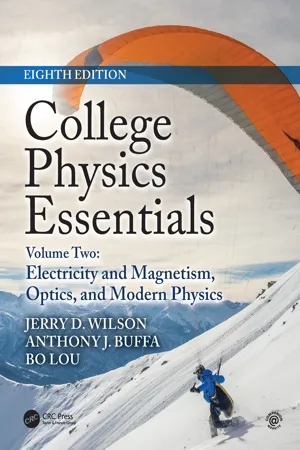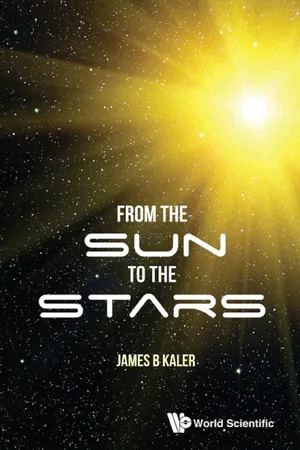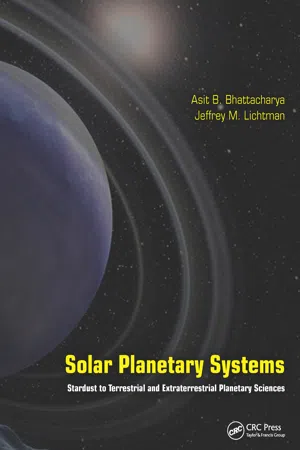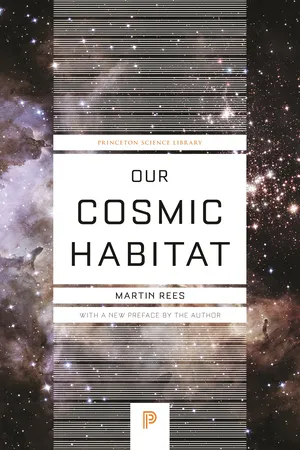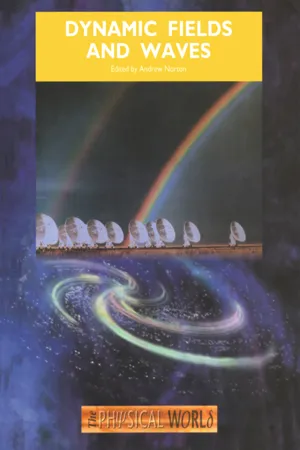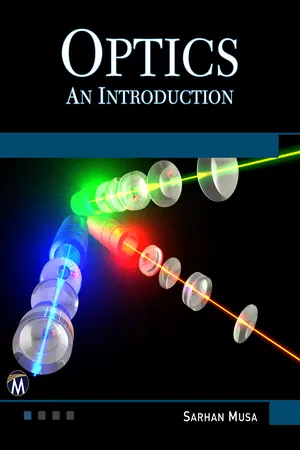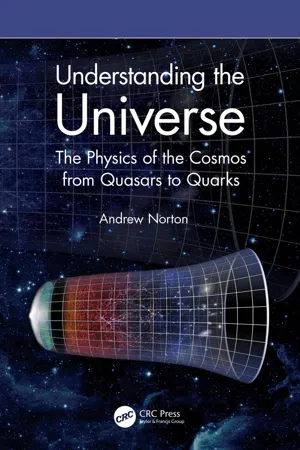Physics
Large Diameter Telescopes
Large diameter telescopes are instruments used to observe and study celestial objects such as stars, galaxies, and planets. These telescopes have a larger aperture, which allows them to collect more light and provide higher resolution images. They are essential tools for astronomers to study the universe and make new discoveries.
Written by Perlego with AI-assistance
Related key terms
Related key terms
1 of 4
Related key terms
1 of 3
7 Key excerpts on "Large Diameter Telescopes"
- eBook - ePub
College Physics Essentials, Eighth Edition
Electricity and Magnetism, Optics, Modern Physics (Volume Two)
- Jerry D. Wilson, Anthony J. Buffa, Bo Lou(Authors)
- 2019(Publication Date)
- CRC Press(Publisher)
Figure 25.14b ).Another way of extending our view into space is to put telescopes into orbit around the Earth. Above the atmosphere, the view is unaffected by the twinkling effect of atmospheric turbulence and refraction, and there is no background problem from city lights. In 1990, the optical Hubble Space Telescope (HST) was launched into orbit. Even with a mirror diameter of only 2.4 m, its privileged position has allowed the HST to produce images seven times as clear as those formed by similarly sized Earthbound telescopes. A flawed optics design of the HST was repaired in 1993, and more repairs were performed in 2009 (▼ Figure 25.15 ). The repairs, along with the addition of new instruments, made the HST 90 times as powerful as it was in 1993.Last, you may know that some telescopes use nonvisible radiation such as radio waves, infrared radiation, ultraviolet radiation, X-rays, and gamma rays. 25.4 Diffraction and Resolution▲Figure 25.15Hubble Space Telescope (HST) The HST in the cargo bay of the Space Shuttle Atlantis during its last servicing mission in May, 2009.The diffraction of light places a limitation on our ability to distinguish objects that are close together when microscopes or telescopes are used. This effect can be understood by considering two point sources located far from a narrow slit of width w (▶ Figure 25.16 ). The sources could represent distant stars, for example. In the absence of diffraction, two bright spots, or images, would be observed on a screen. As you know from Section 24.3, however, the slit diffracts the light, and each image is a diffraction pattern that consists of a central maximum with a pattern of weaker bright and dark positions on either side. If the sources are close together, the two central maxima may overlap. In this case, the images cannot be distinguished, or are said to be unresolved. For the images to be resolved - eBook - ePub
- James B Kaler(Author)
- 2016(Publication Date)
- WSPC(Publisher)
The image can then be examined with a second convex lens, the eyepiece, which is set in back of the image and acts as a sort of magnifying glass. Before coming to the focus, starlight rays converge, while beyond it they diverge. The purpose of the eyepiece is to render the diverging rays parallel again so that they can be focused by the eye onto the retina. (Galileo used a concave lens, one thinner in the middle, set in front of the focus, which is less effective and no longer done.) The magnifying power of a telescope is the factor by which it makes things in the sky, or on the ground for that matter, look larger, and is the ratio of the focal length of the objective to that of the eyepiece. We can achieve different powers simply by changing eyepieces that have different focal lengths.That’s the way it was done “in the old days” (were they really better?) and still is among legions of amateurs (in the true sense of the word), whether they are observing from the back yard or at organized star parties. The point is to witness the richness of the heavens first hand with one’s own eyes and mind. While there is room for some visual observation (of variable stars, of ephemeral events on planets, etc.), nobody actually looks through a research telescope anymore except when you can get away with it to sneak a peek. Instead, some sort of detector is placed at the focal plane so as to permanently record the image to take into the office for measurement and study and to store for later generations.The most important characteristic of the objective is its diameter, or aperture, which controls the amount of light that can be gathered from the scene and thus the brightness of the image or the ability to see ever fainter stars. The light gathering power (very different from the magnifying power) of an astronomical telescope depends on the surface area of the lens, which in turn depends on the square of the diameter. A six-inch telescope has a lens six inches wide. For a given focal length, a 12-inch lens will make the scene four times (12/6 = 2, squared) brighter, which also allows you to see stars four times fainter.But there is another reason for size, one not often expressed. When passing a barrier, light waves bend and interfere with one another, a process called “diffraction.” Even though an objective may be large, its periphery still acts as a barrier. As a result, the image of a pointlike star is actually a small, smeared out “diffraction disk” that is surrounded by faint diffraction rings. The same phenomenon is responsible for the tight rings around the Moon as seen through translucent clouds, or rings about street lights when viewed through fogged eyeglasses. The larger the lens’s diameter, the smaller the star’s central disk. Larger lenses thus better resolve pointlike sources such as two stars close together and can also reveal more detail on an extended source such as a planet. The minimum separation of two points to be achieved is the “resolving power,” which for a 10-centimeter (four-inch) telescope is theoretically 1.5 seconds of arc, but for a one-meter telescope (ten times as large) is ten times as good, 0.15 seconds of arc. Because of aperture’s supreme importance, large telescopes are named by their lens (or mirror) diameters, giving us “the 36-inch” of Lick Observatory in California or “the 200-inch” of Palomar. - eBook - ePub
Solar Planetary Systems
Stardust to Terrestrial and Extraterrestrial Planetary Sciences
- Asit B. Bhattacharya, Jeffrey M. Lichtman(Authors)
- 2016(Publication Date)
- CRC Press(Publisher)
Instrument quality : A research telescope is only as good as the cameras and other instruments which record and analyze the light that it captures. Instruments are judged by factors like the quality of their images, how effectively they spread out light, and how much light they capture.FIGURE 19.10 Lower and higher resolution images.19.7 NASA’s Great Observatories
The four Great Observatories are a series of space telescopes with a purpose to give the complete picture of objects at different wavelengths. Each observatory investigates a particular wavelength region in a greater detail [6 , 7, and 8 ].The telescopes, in order of launch, are (1) the Hubble Space Telescope (1990); (2) Compton Gamma Ray Observatory, popularly called CGRO (1991); (3) Chandra X-ray Observatory (1999); and (4) Spitzer Space Telescope (2003). Figure 19.11 shows each telescope including the wavelength region it was built to observe. All except for CGRO are providing information at present.Figure 19.12 exhibits the images showing the remains of an exploded star (Kepler’s supernova), as seen by three telescopes of the Great Observatories.19.7.1 Hubble Space Telescope’s Design
The Hubble Space Telescope was deployed from the space shuttle Discovery during STS-31 on April 25, 1990. Since then, there have been five servicing missions that continued to upgrade the telescope’s scientific instruments and operational systems. Hubble reached a major milestone, its twentieth anniversary in orbit, on April 24, 2010.As seen in Figure 19.13 , when light hits the “concave” primary mirror, it is reflected to the convex secondary mirror, then returns through a hole in the center of the “primary mirror.” The light comes to the “focal point” and then passes to one of Hubble’s “instruments.” Telescopes of this design are called Cassegrain telescopes, after the person who first designed the same. Figure 19.13a shows the design of the telescope [9 , 10 and 11 ].Hubble is one of the largest and most versatile and is well known as both a vital research tool and a public relations boon for astronomy. The telescope (Figure 19.13b ) was built by the United States space agency NASA with contributions from the European Space Agency. This is operated by the Space Telescope Science Institute [9 - eBook - ePub
- Martin Rees(Author)
- 2017(Publication Date)
- Princeton University Press(Publisher)
Hubble could study galaxies that are only relatively close to us—those whose recession speeds were less than one percent of the speed of light. Thanks to larger telescopes, and (even more) to improved sensors for detecting faint light, the data now extend much farther, revealing galaxies so far away that their recession speeds are 90 percent the speed of light. The light from these very remote galaxies started to travel when they were several billion years younger and the universe was more compressed (in other words, when the imaginary rods joining them were all shorter). We must allow for the effects of relativity and the expansion of space in inferring the speeds and distances.Telescopes: In Space and on the Ground
Progress in astronomy does not come from armchair theorists, even when they are aided by teraflop computers: it mainly depends on observations and on high-precision instruments right at the limit of technology. Astronomy has a longer history than any other science, except perhaps medicine. It was the first to involve precise measurement, and perhaps the first to do more good than harm. It was certainly the first to need large instruments. Astronomical artifacts—astrolabes, clocks, and telescopes—have been (and still are) monuments to human ingenuity and, as a bonus, often of great aesthetic appeal as well.Throughout the last century, optical telescopes were built with progressively larger mirrors, enabling them to collect more light. By the 1980s, more than a dozen had mirror diameters exceeding 4 meters. The power of these telescopes dramatically improved when traditional photographic film was superseded by light-sensitive microelectronic chips called charged-coupled devices. The efficiency for detecting faint light went up from 1 to 80 percent of the theoretical maximum, giving these 4-meter telescopes an immense boost. But, having achieved such high efficiency, the only way to detect still fainter objects is by collecting yet more light, and this requires even larger mirrors. Telescopes with mirrors 8 or 10 meters across can collect four times more light from very faint and remote galaxies than earlier-generation ground-based telescopes. The two Keck Telescopes in Hawaii are now being complemented by several more. Most impressive of all is the unimaginatively named Very Large Telescope, a connected cluster of four telescopes, each with an 8.2-meter mirror, constructed in the Chilean Andes by a consortium of European nations. - eBook - ePub
- A Norton(Author)
- 2019(Publication Date)
- CRC Press(Publisher)
Figure 3.44 ), and at the time of writing (2000) were the largest in the world.Figure 3.44 The Gemini North telescope, at an observatory on Mauna Kea, Hawaii, with its 8 m diameter primary mirror.On the debit side for reflecting telescopes, there is greater loss of optical intensity than in the refractors, because the reflecting surfaces are never quite perfect and may have appreciable absorption (10 per cent or more). Aluminium surfaces also deteriorate rather quickly and have to be renewed relatively frequently. On the other hand, a perfectly polished lens remains serviceable for many years.4.6 The camera
This brief survey of optical systems concludes with a discussion of perhaps the most familiar of all optical devices — the photographic camera. The first permanent photograph was taken in 1826 by Joseph Nicephore Niepce using a box camera with a small converging lens. Modern cameras (Figure 3.45 ) have come a long way since the designs of the early nineteenth century, but the principles remain broadly the same.Figure 3.45 A modern camera.In many ways, the camera is simply a ‘mechanical eye’, being composed of elements that mimic the most important components in the human eye. It has a converging lens, which focuses a real, inverted image onto a photosensitive surface called film (see Figure 3.46 ); it has an iris diaphragm — often called a stop — which, like the iris in the eye, can be adjusted to change the size of the central aperture-stop (equivalent to the eye’s pupil), and so control the amount of light entering the camera; and, though this is pushing the analogy rather hard, the camera has a shutter - eBook - ePub
Optics
An Introduction
- Sarhan M. Musa(Author)
- 2020(Publication Date)
- Mercury Learning and Information(Publisher)
Telescopes are generally employed to form an image at infinity of an infinitely distant object like a star. They may also be employed, for example, for simple laboratory experiments, to form an image at a finite distance of an object located at a finite distance from it. Telescopes may be conveniently divided into two general classes: (a) those employing lenses as objectives, called refracting telescopes; and (b) those employing mirrors as objectives, called reflecting telescopes. These are further subdivided into the astronomical class and the terrestrial class, depending upon whether the final magnified image as seen by the eye is inverted or erect with respect to the object under examination.5.6 THE ASTRONOMICAL REFRACTING TELESCOPEThe optical system of the astronomical refracting telescope is illustrated by Figure 5.6 .FIGURE 5.6. The astronomical telescope.O1 O2 is the objective of a long focal length on which is incident a parallel beam of light from an off-axial distant object point, making an angle i with the axis of the instrument. The objective refracts this beam so that the refracted beam converges at Q′ in the second principal focal plane of the objective. This image, which is real and inverted with respect to the distant object, acts as a real object for the eyepiece, and if the first principal focal plane of the eyepiece coincides with the second principal focal plane of the objective, the so-called normal adjustment, then after refraction by the eyepiece, rays emerge as a parallel beam. The direction of the emergent beam is parallel to the line joining the point Q′ to Oe , the optical center of the eyepiece, because if we imagine the ray Q′Qe to exist, it would emerge from the eyepiece without any deviation from its path. Thus, a virtual magnified image is formed at infinity of the real image P′Q′, the latter being the image of an object and formed due to the refraction through the objective.The objective is at one end of a large tube, while the eyepiece is usually fixed in a smaller tube which is inserted in the larger one at its other end. Thus, the focus can be adjusted to suit any eye. The rim of the objective limits the width of the beam incident on the telescope. As a consequence, the objective itself serves as an entrance pupil of the instrument. A real image of the objective formed by the eyepiece is therefore the exit pupil of the instrument. The ray entering the telescope through the optical center of the objective, which is also the center of the entrance pupil, is called the chief ray, and this ray must finally pass through the center of the exit pupil. Rays entering at the rim of the objective must pass through the conjugate points on the rim of the exit pupil, as illustrated by Figure 5.6 - eBook - ePub
Understanding the Universe
The Physics of the Cosmos from Quasars to Quarks
- Andrew Norton(Author)
- 2021(Publication Date)
- CRC Press(Publisher)
Unaided human eyes are not very suitable for astronomical observation. First, the eye has a limited sensitivity – a distant source of light, such as a star, will not be seen at all unless the intensity of light from it reaching your eye is above the sensitivity threshold of the retina. Second, the acuity of the eye is limited by the physical size of the detectors on the retina and by the small aperture of the eye. This limited resolution makes it impossible for human eyes to separate individual distant sources of light that are too close together or to make out details of their shape or structure.The minimum separation at which objects may be distinguished is referred to as the limit of angular resolution. As you know, there are 360 degrees in a complete circle. Each degree may be subdivided into 60 arcminutes, and each arcminute further subdivided into 60 arcseconds. The typical angular resolution of the unaided human eye is about 1 arcminute and corresponds to (say) the size of a tennis ball seen from over 200 metres away. The angular diameter of the Sun or full Moon seen from Earth are each about 30 arcminutes.The invention of the telescope at the beginning of the 17th century was an important milestone in the advancement of astronomy. It provided a simple instrument that overcame, at least in part, these shortcomings of human eyes. This section will first consider the various designs of refracting telescopes and reflecting telescopes that have been developed over the past four centuries, and then look at the main ways of characterizing the performance of an astronomical telescope. An important piece of nomenclature is as follows: the name refracting telescope (or refractor, for short) is used to indicate a telescope in which only lenses are used to form the image; the name reflecting telescope (or reflector for short) is used to indicate a telescope in which a curved mirror is used in place of the objective lens.Although, in this section, telescopes that operate in the visible part of the electromagnetic spectrum (i.e. wavelengths of a few hundred nanometres) will be described, the principles may be applied similarly to telescopes that operate in the near-infrared and near-ultraviolet (i.e. wavelengths of a few micrometres and around 100 nanometres, respectively). These regions of the electromagnetic spectrum are invisible to human eyes, but the radiation can be focused by telescopes and detected electronically in much the same way as described in this section.
Index pages curate the most relevant extracts from our library of academic textbooks. They’ve been created using an in-house natural language model (NLM), each adding context and meaning to key research topics.
Explore more topic indexes
Explore more topic indexes
1 of 6
Explore more topic indexes
1 of 4
